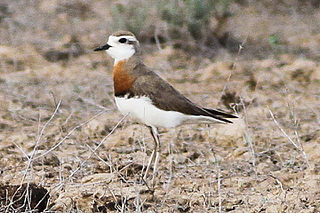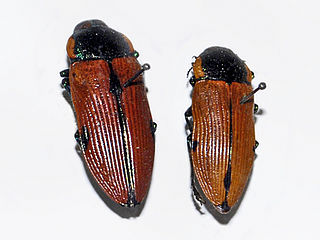
The Caspian plover is a wader in the plover family of birds. The specific asiaticus is Latin and means "Asian", although in binomials it usually means the type locality was India.

The Cupedidae are a small family of beetles, notable for the square pattern of "windows" on their elytra, which give the family their common name of reticulated beetles.

The banded hare-wallaby, mernine, or munning is a marsupial currently found on the islands of Bernier and Dorre off western Australia. Reintroduced populations have recently been established on islands and fenced mainland sites, including Faure Island and Wadderin Sanctuary near Narembeen in the central wheatbelt.

Buprestidae is a family of beetles known as jewel beetles or metallic wood-boring beetles because of their glossy iridescent colors. Larvae of this family are known as flatheaded borers. The family is among the largest of the beetles, with some 15,500 species known in 775 genera. In addition, almost 100 fossil species have been described.

Myxophaga is the second-smallest suborder of the Coleoptera after Archostemata, consisting of roughly 65 species of small to minute beetles in four families. The members of this suborder are aquatic and semiaquatic, and feed on algae.

The motorbike frog is a ground-dwelling tree frog of the subfamily Pelodryadinae found in Southwest Australia. Its common name is derived from the male frog's mating call, which sounds similar to a motorbike changing up through gears; it is also known as Moore's frog, the western bell frog, western green and golden bell frog, and western green tree frog. The Noongar name for it is Kyooya.Note 1

Cleridae are a family of beetles of the superfamily Cleroidea. They are commonly known as checkered beetles. The family Cleridae has a worldwide distribution, and a variety of habitats and feeding preferences.

The rough-scaled python is a large-scaled python species endemic to Australia. No subspecies are currently recognized.

The inland broad-nosed bat is a species of vesper bat. They are endemic to Australia and widespread throughout the inland, especially in arid and semi-arid regions. This insectivorous microbat, measuring 12 centimetres (4.7 in) in length, roosts in tree hollows during the day and forages over woodland and water at night.

The orange leaf-nosed bat is a bat in the family Rhinonycteridae. It is the only living species in the genus Rhinonicteris which is endemic to Australia, occurring in the far north and north-west of the continent. They roost in caves, eat moths, and are sensitive to human intrusion.

Blepharotes coriarius, the giant yellow robber fly, is a species of large predatory fly from Australia in the family Asilidae. It was described by the German naturalist Christian Rudolph Wilhelm Wiedemann in 1830.

Eupoecila australasiae, commonly known as the fiddler beetle or rose chafer, is a colourful green- or yellow-and-black member of the scarab beetle family from eastern Australia.

Temognatha variabilis, commonly known as the variable jewel beetle, is a beetle of the family Buprestidae.

Eupoecila is a genus of scarab beetle family that includes five species, all of which are found in Australia.
Oreodera inscripta is a species of long-horned beetle in the family Cerambycidae. It is found in Costa Rica, Honduras, Nicaragua and Panama.

Eupoecila evanescens, commonly known as the orange spot beetle is a member of the scarab beetle family from north-eastern Australia, belonging to genus Eupoecila.

Eupoecila intricata is a rare species of the Australian-endemic scarab beetle genus Eupoecila. E. intricata was described by Lea (1914) as a subspecies of E. australasiae and is still often confused with the species. It was raised to species status by Allard (1995).
Eupoecila miskini is a member of the scarab beetle family indigenous to Australia, belonging to genus Eupoecila. It is closely related to Eupoecila inscripta.

Cadmus is a genus of leaf beetles which are commonly called case bearing leaf beetles in the subfamily Chrysomelinae. They are widespread throughout Australia and include 5 subgenera and 68 species.

Eucalyptus occidentalis, commonly known as the flat topped yate or the swamp yate, is a tree that is native to Western Australia. The Noongar names for the tree are Mo or Yundill.

















